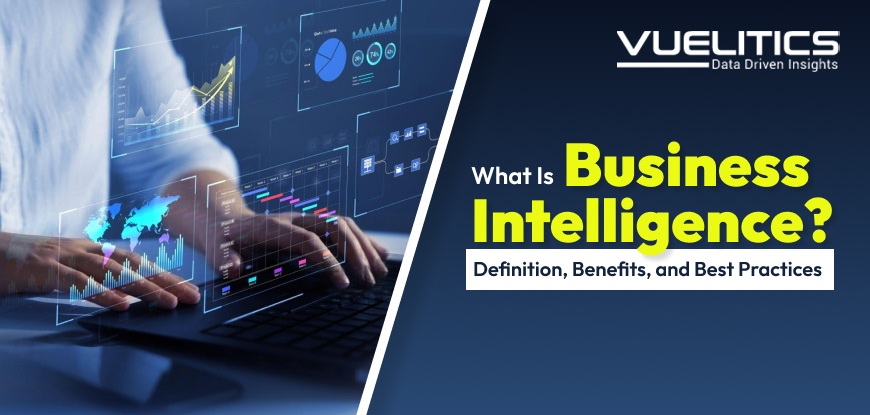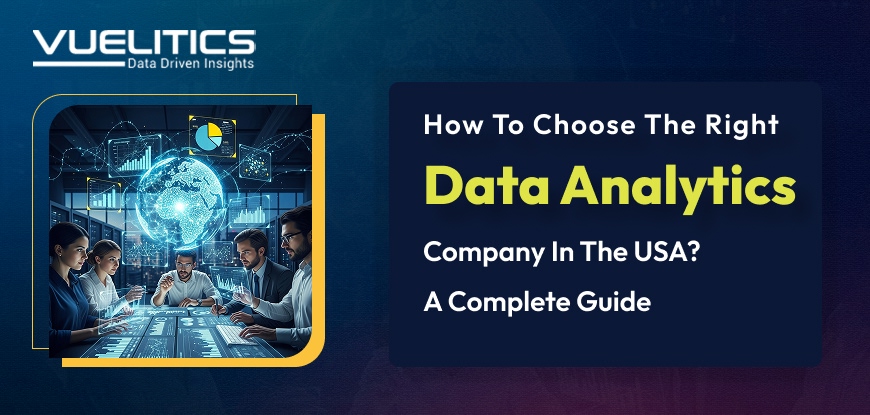- Home
- Blogs

What Is Business Intelligence? Definition, Benefits, And Best Practices
For businesses in the digital-driven world today, data is among the most precious commodities. But data alone cannot generate value until and unless it is appropriately collected, analyzed, and converted into actionable insights. This is exactly where Business Intelligence (BI) adds value to organizations. BI has evolved from startups to brick and mortar to become a game changer in making better decisions, minimizing risks, and discovering industries.
This blog post will dive into what business intelligence is and the benefits of it, best practices, and how business analytics tools and analysts keep your company ahead of the competition.
What is Business Intelligence?
So, what the heck is BI? Fundamentally, business intelligence involves an organization’s ability to gather, integrate, analyze, and display business information in a manner that facilitates more effective decision-making.
It is a collection of data analysis, reporting, dashboards, and visualization tools that ultimately allows businesses to see exactly what is going on with their operations, performance, and market. By making sense of raw data, BI helps business leaders to base decisions on evidence rather than intuition.
Put another way: if you were to ask, “what is the definition of business intelligence?” It’s turning data into information that drives more intelligent business decisions.
What is a BI Analyst?
A BI developer is a professional dedicated to analyzing business data, creating reports, and discovering patterns that can help companies achieve their goals. Their tools are business intelligence (BI) tools; they cleanse and visualize and interpret data, so you let decision-makers access it.
For example, a BI analyst might review customer purchasing trends to recommend better pricing practices or assess supply chain performance in an effort to control costs. They are an essential cog in the wheel between database management and business strategy.
What is Business Intelligence and Analytics?
Though the terms BI and Analytics are very much interlinked, there are nuances, the differences being more or less – Business intelligence is primarily concerned with descriptive analysis, which includes both what occurred in the past and what presently is occurring. Business analytics, on the other hand, is primarily concerned with predictive and prescriptive analysis, which seeks to answer questions such as why something occurred and what might occur in the future.
By coming together, BI and analytics establish a complete set of tools for organizations to see how their performance is doing now and prepare for what’s to come.
Benefits of Business Intelligence
Developing BI may lead to several benefits for businesses. Here are some of the most significant:
Data-Driven Decision-Making
Businesses no longer need to make decisions by gut — Best of all, BI enables decision-making in real time. This minimizes risks and improves the accuracy of strategic planning.
Improved Operational Efficiency
BI tools automate the process of gathering data and reporting, which translates into saved time for employees, as well as quicker access to important insights. This efficiency is what allows institutions to grapple with challenges promptly.
Enhanced Customer Experience
Acquiring data from such BI allows companies to understand customer preferences and feedback on customer behavior. These learning’s enhance products, tailor services and enhance connection to the customer.
Competitive Advantage
Three benefits of BI for business intelligence gives businesses a more detailed insight into their market’s trends, competitors’ performance, and industry changes. This kind of prophecy enables them to anticipate and outflank rivals.
Financial Performance Monitoring
Revenue projections, expense tracking: BI makes financial analysis a snap. Companies can maximize their budgeting and find ways to reduce extra spending.
Data Transparency Across Teams
Thanks to BI and its centralized dashboards and reports, everyone from executives to front-line employees is working from aligned, trusted data. Heck, this insight leads to greater cooperation and responsibility.
Popular Business Intelligence Tools
And now that BI is so popular, there are some serious BI tools available to help businesses work with data and represent it visually, which offer more powerful features than ever. Some tools that are frequently utilized include:
- Interactive dashboards, excellent connectivity with other Microsoft applications, and real-time analytics are some of the characteristics that are associated with Power BI (a Microsoft product).
- Tableau is an intuitive graphical representation of data that works best for narratives that are based on charts and graphs.
- In addition to providing associative data modeling, Qlik Sense also provides AI-based insight generation.
- A cloud-native product that includes advanced data analytics and embedded business intelligence functions, Looker is offered by Google.
- A business-grade solution that includes powerful reporting and performance management capabilities, SAP Business-objects is an enterprise business solution.
- Among SAP’s enterprise-level offerings, Business-objects stands out for its powerful reporting and performance management features.
Real-World Business Intelligence Examples
So, to understand how BI can be influential, consider a few examples:
- Retail: For retail shops, business intelligence allows them to monitor sales trends, stock volume levels and pricing strategies when seasonal demand is high.
- Healthcare In healthcare, used to monitor patient flow, forecast staffs needs and enhance treatment results.
- Finance: Banks use BI to identify embezzlement and other fraudulent transactions, evaluate credit risk, and better serve customers.
- Distribution: Shippers track their shipments to optimize delivery routes and limit the cost of transportation.
Such examples highlight the role of business intelligence in helping organizations across sectors enhance performance and profits.
Best Practices for Implementing Business Intelligence
More than merely installing software is required for a successful adoption of business intelligence. For the purpose of maximizing value, the following are some best practices:
Define Clear Objectives
Before they deploy BI, businesses need their purpose—be that raising customer retention, cutting costs, or increasing sales. The goals are very clear throughout the whole process.
Choose the Right BI Tools
Different BI tools cater to different requirements. Small businesses might emphasize both price and simplicity, while enterprises require complex customization and scalability.
Ensure Data Quality
The conclusions of BI are only as useful as the data supplied to it. Companies must clean, standardize and verify their data to avoid incorrect outcomes.
Promote Data Literacy
Your BI tool is worthless if nobody knows how to use it. Training teams in data literacy equips them to read reports and respond to insights.
Start Small, Scale Gradually
Rather than rolling BI out to all departments all at once, businesses should begin with small test projects, Experts said. This enables them to iteratively improve processes prior to scaling across their company.
Monitor and Improve Continuously
BI is not a project but rather a process that repeats itself. By constantly refreshing dashboards, adding new sources and improving reports, insights can remain fresh.
Future of Business Intelligence
With AI, ML and cloud computing in full swing, the future of BI is increasingly dynamic and, in fact, predictive. Self-Serve BI tools are enabling business users, and automation is winnowing the stacks of manual reporting. BI with real-time analytics and big data will further disrupt how businesses use insights to maintain pace or lead.
Conclusion
So, there you have it: business intelligence is not only a buzzword—it’s a strategic imperative in today’s data-driven economy. If you’re wondering “what is BI” or “what is a BI analyst” or even “what is business intelligence and analytics,” it’s all about realizing the potential of data to make better business decisions.
Best BI tools implemented with the best practices, combined with a culture of relying on data to make decisions helps with the organizations to be more competitive and to perform better, eventually providing value to the customers.



Post Comments